University Student Depression: A Research Proposal
VerifiedAdded on 2020/05/08
|15
|2893
|50
Project
AI Summary
This research proposal investigates the prevalence of depression among Australian university students. It aims to identify the rates of clinically significant depression and associated risk factors, acknowledging the existing literature gap in this specific area. The research will employ a positivism philosophy, using a deductive approach and a multi-method approach, combining both quantitative and qualitative data analysis through surveys and questionnaires. The methodology includes a sampling strategy involving 100 university students from a reputed Australian university, with data collection scheduled to begin on September 26th. The study will ensure participant confidentiality. The research will explore the students' personal and university experiences related to depression, suggesting recommendations to address the issues and potentially improve mental health support for students. The study also highlights the importance of addressing mental health challenges in young adults.

Running head: PSYCHOLOGY
Research Proposal: Depression among Australian University Students
Student Name
University name
Author Note
Research Proposal: Depression among Australian University Students
Student Name
University name
Author Note
Paraphrase This Document
Need a fresh take? Get an instant paraphrase of this document with our AI Paraphraser

PSYCHOLOGY
Abstract
This research aims to identify the rate of depression among the Australian university students
and the risk factors associated with it. In order to identify the issues selected existed literature are
reviewed and analysed. It has been observed that the specific area of depression among
Australian students has not yet been explored. Even there are gaps in the literature and researches
as they had generally treated depression as generalized psychological problem rather than a
serious illness. The researcher will follow various research methodologies to conduct study and
the outcomes will be analysed that will guide the research towards its desired destination. The
researcher will try to suggest some effective recommendations in order to resolve the issues.
Keywords: Rate of depression, risk factors, Australian university students
Abstract
This research aims to identify the rate of depression among the Australian university students
and the risk factors associated with it. In order to identify the issues selected existed literature are
reviewed and analysed. It has been observed that the specific area of depression among
Australian students has not yet been explored. Even there are gaps in the literature and researches
as they had generally treated depression as generalized psychological problem rather than a
serious illness. The researcher will follow various research methodologies to conduct study and
the outcomes will be analysed that will guide the research towards its desired destination. The
researcher will try to suggest some effective recommendations in order to resolve the issues.
Keywords: Rate of depression, risk factors, Australian university students
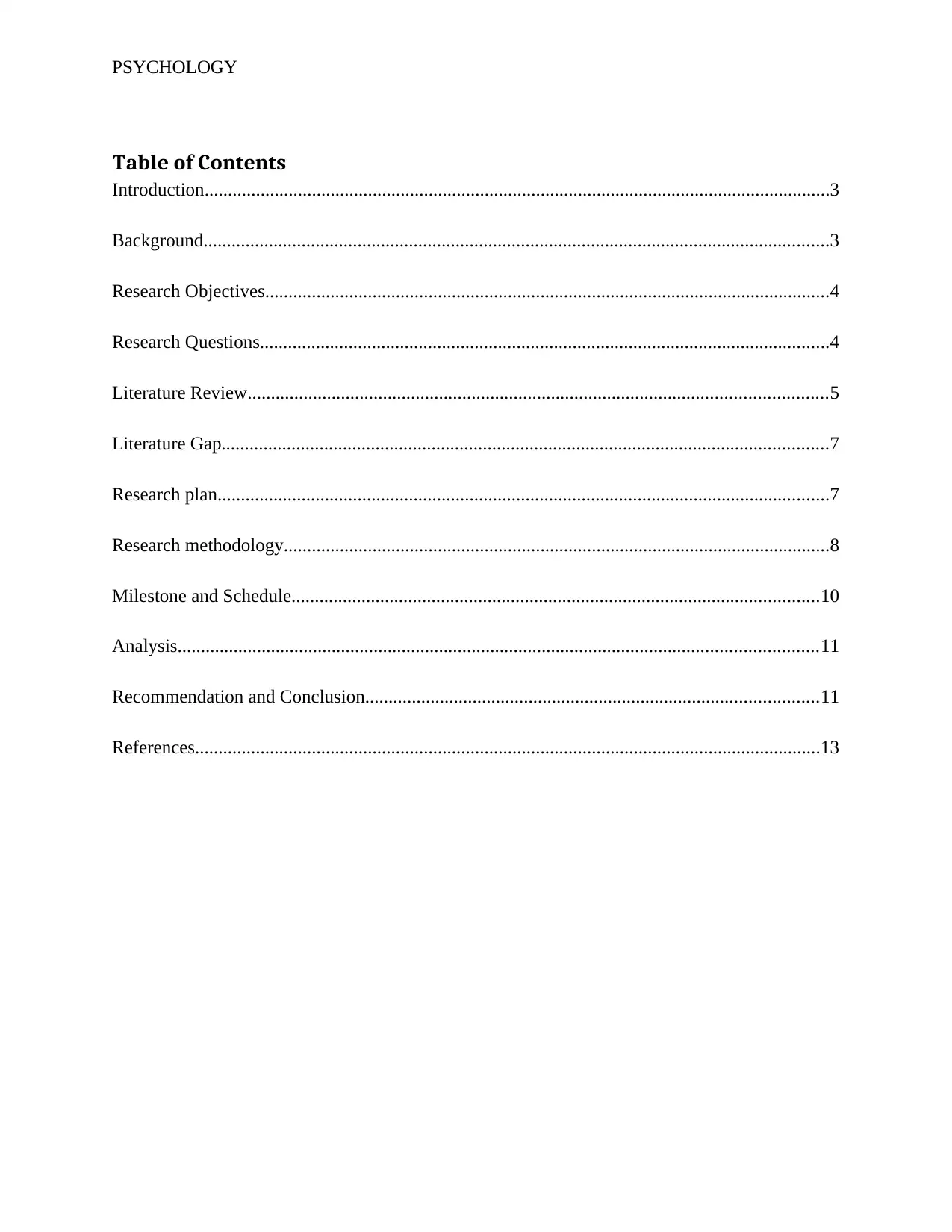
PSYCHOLOGY
Table of Contents
Introduction......................................................................................................................................3
Background......................................................................................................................................3
Research Objectives.........................................................................................................................4
Research Questions..........................................................................................................................4
Literature Review............................................................................................................................5
Literature Gap..................................................................................................................................7
Research plan...................................................................................................................................7
Research methodology.....................................................................................................................8
Milestone and Schedule.................................................................................................................10
Analysis.........................................................................................................................................11
Recommendation and Conclusion.................................................................................................11
References......................................................................................................................................13
Table of Contents
Introduction......................................................................................................................................3
Background......................................................................................................................................3
Research Objectives.........................................................................................................................4
Research Questions..........................................................................................................................4
Literature Review............................................................................................................................5
Literature Gap..................................................................................................................................7
Research plan...................................................................................................................................7
Research methodology.....................................................................................................................8
Milestone and Schedule.................................................................................................................10
Analysis.........................................................................................................................................11
Recommendation and Conclusion.................................................................................................11
References......................................................................................................................................13
⊘ This is a preview!⊘
Do you want full access?
Subscribe today to unlock all pages.

Trusted by 1+ million students worldwide
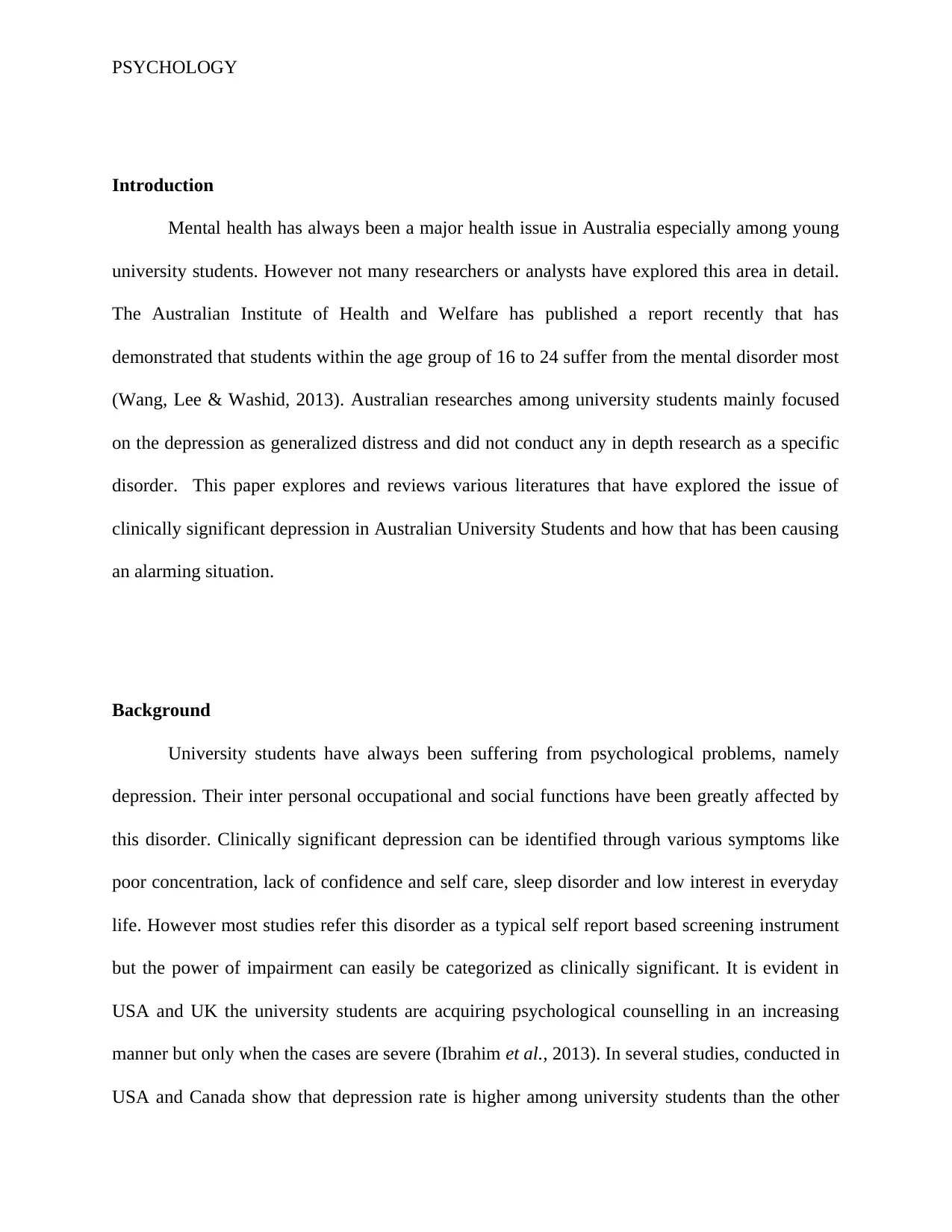
PSYCHOLOGY
Introduction
Mental health has always been a major health issue in Australia especially among young
university students. However not many researchers or analysts have explored this area in detail.
The Australian Institute of Health and Welfare has published a report recently that has
demonstrated that students within the age group of 16 to 24 suffer from the mental disorder most
(Wang, Lee & Washid, 2013). Australian researches among university students mainly focused
on the depression as generalized distress and did not conduct any in depth research as a specific
disorder. This paper explores and reviews various literatures that have explored the issue of
clinically significant depression in Australian University Students and how that has been causing
an alarming situation.
Background
University students have always been suffering from psychological problems, namely
depression. Their inter personal occupational and social functions have been greatly affected by
this disorder. Clinically significant depression can be identified through various symptoms like
poor concentration, lack of confidence and self care, sleep disorder and low interest in everyday
life. However most studies refer this disorder as a typical self report based screening instrument
but the power of impairment can easily be categorized as clinically significant. It is evident in
USA and UK the university students are acquiring psychological counselling in an increasing
manner but only when the cases are severe (Ibrahim et al., 2013). In several studies, conducted in
USA and Canada show that depression rate is higher among university students than the other
Introduction
Mental health has always been a major health issue in Australia especially among young
university students. However not many researchers or analysts have explored this area in detail.
The Australian Institute of Health and Welfare has published a report recently that has
demonstrated that students within the age group of 16 to 24 suffer from the mental disorder most
(Wang, Lee & Washid, 2013). Australian researches among university students mainly focused
on the depression as generalized distress and did not conduct any in depth research as a specific
disorder. This paper explores and reviews various literatures that have explored the issue of
clinically significant depression in Australian University Students and how that has been causing
an alarming situation.
Background
University students have always been suffering from psychological problems, namely
depression. Their inter personal occupational and social functions have been greatly affected by
this disorder. Clinically significant depression can be identified through various symptoms like
poor concentration, lack of confidence and self care, sleep disorder and low interest in everyday
life. However most studies refer this disorder as a typical self report based screening instrument
but the power of impairment can easily be categorized as clinically significant. It is evident in
USA and UK the university students are acquiring psychological counselling in an increasing
manner but only when the cases are severe (Ibrahim et al., 2013). In several studies, conducted in
USA and Canada show that depression rate is higher among university students than the other
Paraphrase This Document
Need a fresh take? Get an instant paraphrase of this document with our AI Paraphraser
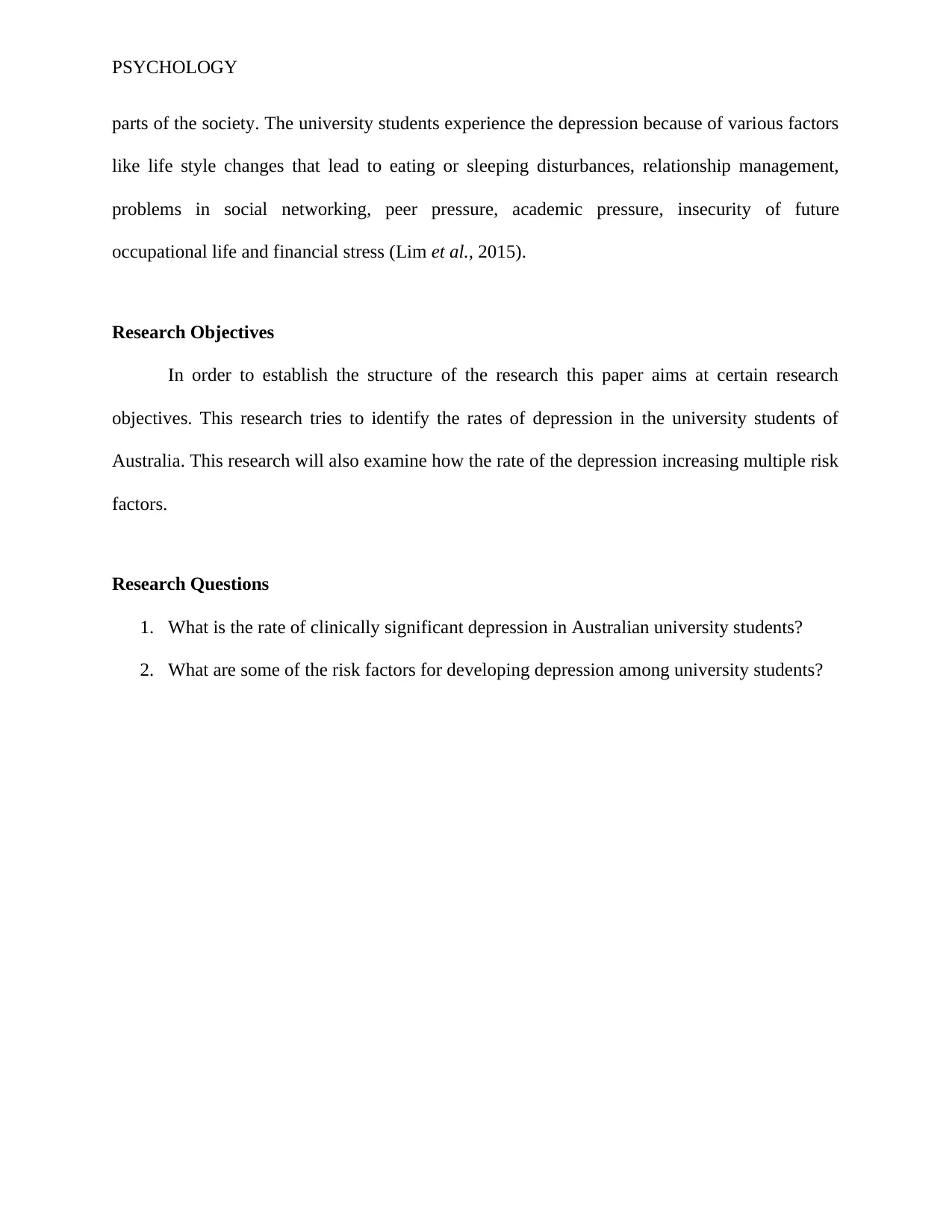
PSYCHOLOGY
parts of the society. The university students experience the depression because of various factors
like life style changes that lead to eating or sleeping disturbances, relationship management,
problems in social networking, peer pressure, academic pressure, insecurity of future
occupational life and financial stress (Lim et al., 2015).
Research Objectives
In order to establish the structure of the research this paper aims at certain research
objectives. This research tries to identify the rates of depression in the university students of
Australia. This research will also examine how the rate of the depression increasing multiple risk
factors.
Research Questions
1. What is the rate of clinically significant depression in Australian university students?
2. What are some of the risk factors for developing depression among university students?
parts of the society. The university students experience the depression because of various factors
like life style changes that lead to eating or sleeping disturbances, relationship management,
problems in social networking, peer pressure, academic pressure, insecurity of future
occupational life and financial stress (Lim et al., 2015).
Research Objectives
In order to establish the structure of the research this paper aims at certain research
objectives. This research tries to identify the rates of depression in the university students of
Australia. This research will also examine how the rate of the depression increasing multiple risk
factors.
Research Questions
1. What is the rate of clinically significant depression in Australian university students?
2. What are some of the risk factors for developing depression among university students?
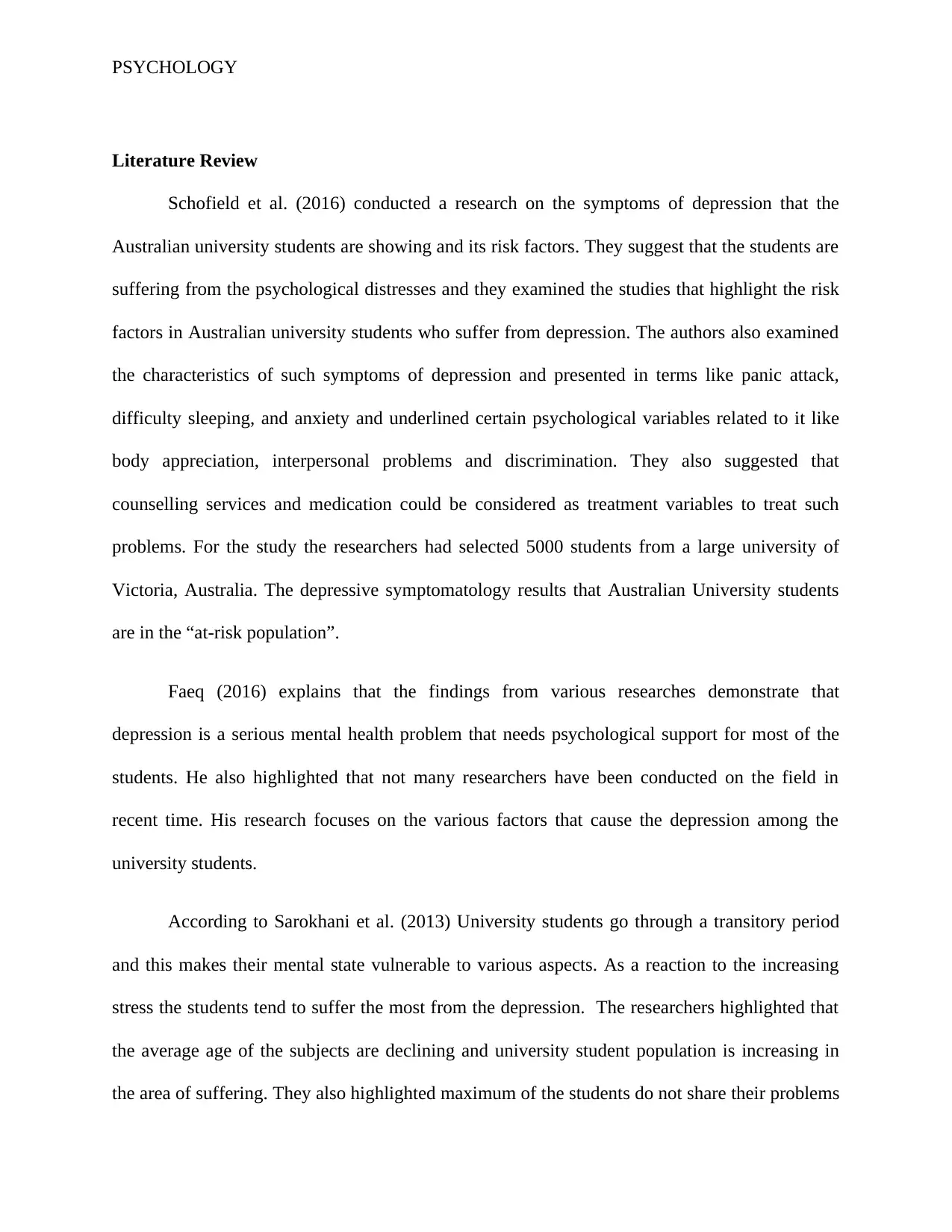
PSYCHOLOGY
Literature Review
Schofield et al. (2016) conducted a research on the symptoms of depression that the
Australian university students are showing and its risk factors. They suggest that the students are
suffering from the psychological distresses and they examined the studies that highlight the risk
factors in Australian university students who suffer from depression. The authors also examined
the characteristics of such symptoms of depression and presented in terms like panic attack,
difficulty sleeping, and anxiety and underlined certain psychological variables related to it like
body appreciation, interpersonal problems and discrimination. They also suggested that
counselling services and medication could be considered as treatment variables to treat such
problems. For the study the researchers had selected 5000 students from a large university of
Victoria, Australia. The depressive symptomatology results that Australian University students
are in the “at-risk population”.
Faeq (2016) explains that the findings from various researches demonstrate that
depression is a serious mental health problem that needs psychological support for most of the
students. He also highlighted that not many researchers have been conducted on the field in
recent time. His research focuses on the various factors that cause the depression among the
university students.
According to Sarokhani et al. (2013) University students go through a transitory period
and this makes their mental state vulnerable to various aspects. As a reaction to the increasing
stress the students tend to suffer the most from the depression. The researchers highlighted that
the average age of the subjects are declining and university student population is increasing in
the area of suffering. They also highlighted maximum of the students do not share their problems
Literature Review
Schofield et al. (2016) conducted a research on the symptoms of depression that the
Australian university students are showing and its risk factors. They suggest that the students are
suffering from the psychological distresses and they examined the studies that highlight the risk
factors in Australian university students who suffer from depression. The authors also examined
the characteristics of such symptoms of depression and presented in terms like panic attack,
difficulty sleeping, and anxiety and underlined certain psychological variables related to it like
body appreciation, interpersonal problems and discrimination. They also suggested that
counselling services and medication could be considered as treatment variables to treat such
problems. For the study the researchers had selected 5000 students from a large university of
Victoria, Australia. The depressive symptomatology results that Australian University students
are in the “at-risk population”.
Faeq (2016) explains that the findings from various researches demonstrate that
depression is a serious mental health problem that needs psychological support for most of the
students. He also highlighted that not many researchers have been conducted on the field in
recent time. His research focuses on the various factors that cause the depression among the
university students.
According to Sarokhani et al. (2013) University students go through a transitory period
and this makes their mental state vulnerable to various aspects. As a reaction to the increasing
stress the students tend to suffer the most from the depression. The researchers highlighted that
the average age of the subjects are declining and university student population is increasing in
the area of suffering. They also highlighted maximum of the students do not share their problems
⊘ This is a preview!⊘
Do you want full access?
Subscribe today to unlock all pages.

Trusted by 1+ million students worldwide
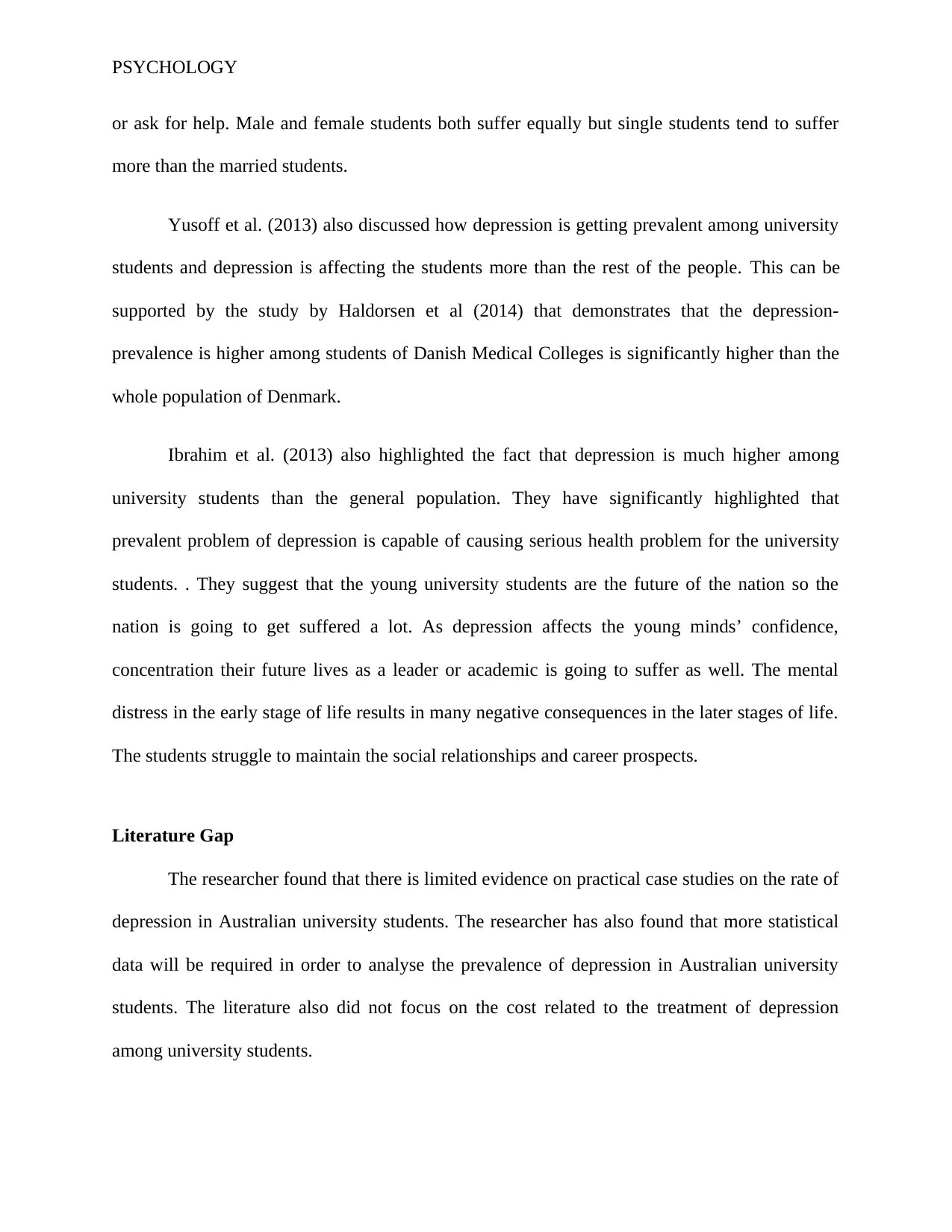
PSYCHOLOGY
or ask for help. Male and female students both suffer equally but single students tend to suffer
more than the married students.
Yusoff et al. (2013) also discussed how depression is getting prevalent among university
students and depression is affecting the students more than the rest of the people. This can be
supported by the study by Haldorsen et al (2014) that demonstrates that the depression-
prevalence is higher among students of Danish Medical Colleges is significantly higher than the
whole population of Denmark.
Ibrahim et al. (2013) also highlighted the fact that depression is much higher among
university students than the general population. They have significantly highlighted that
prevalent problem of depression is capable of causing serious health problem for the university
students. . They suggest that the young university students are the future of the nation so the
nation is going to get suffered a lot. As depression affects the young minds’ confidence,
concentration their future lives as a leader or academic is going to suffer as well. The mental
distress in the early stage of life results in many negative consequences in the later stages of life.
The students struggle to maintain the social relationships and career prospects.
Literature Gap
The researcher found that there is limited evidence on practical case studies on the rate of
depression in Australian university students. The researcher has also found that more statistical
data will be required in order to analyse the prevalence of depression in Australian university
students. The literature also did not focus on the cost related to the treatment of depression
among university students.
or ask for help. Male and female students both suffer equally but single students tend to suffer
more than the married students.
Yusoff et al. (2013) also discussed how depression is getting prevalent among university
students and depression is affecting the students more than the rest of the people. This can be
supported by the study by Haldorsen et al (2014) that demonstrates that the depression-
prevalence is higher among students of Danish Medical Colleges is significantly higher than the
whole population of Denmark.
Ibrahim et al. (2013) also highlighted the fact that depression is much higher among
university students than the general population. They have significantly highlighted that
prevalent problem of depression is capable of causing serious health problem for the university
students. . They suggest that the young university students are the future of the nation so the
nation is going to get suffered a lot. As depression affects the young minds’ confidence,
concentration their future lives as a leader or academic is going to suffer as well. The mental
distress in the early stage of life results in many negative consequences in the later stages of life.
The students struggle to maintain the social relationships and career prospects.
Literature Gap
The researcher found that there is limited evidence on practical case studies on the rate of
depression in Australian university students. The researcher has also found that more statistical
data will be required in order to analyse the prevalence of depression in Australian university
students. The literature also did not focus on the cost related to the treatment of depression
among university students.
Paraphrase This Document
Need a fresh take? Get an instant paraphrase of this document with our AI Paraphraser
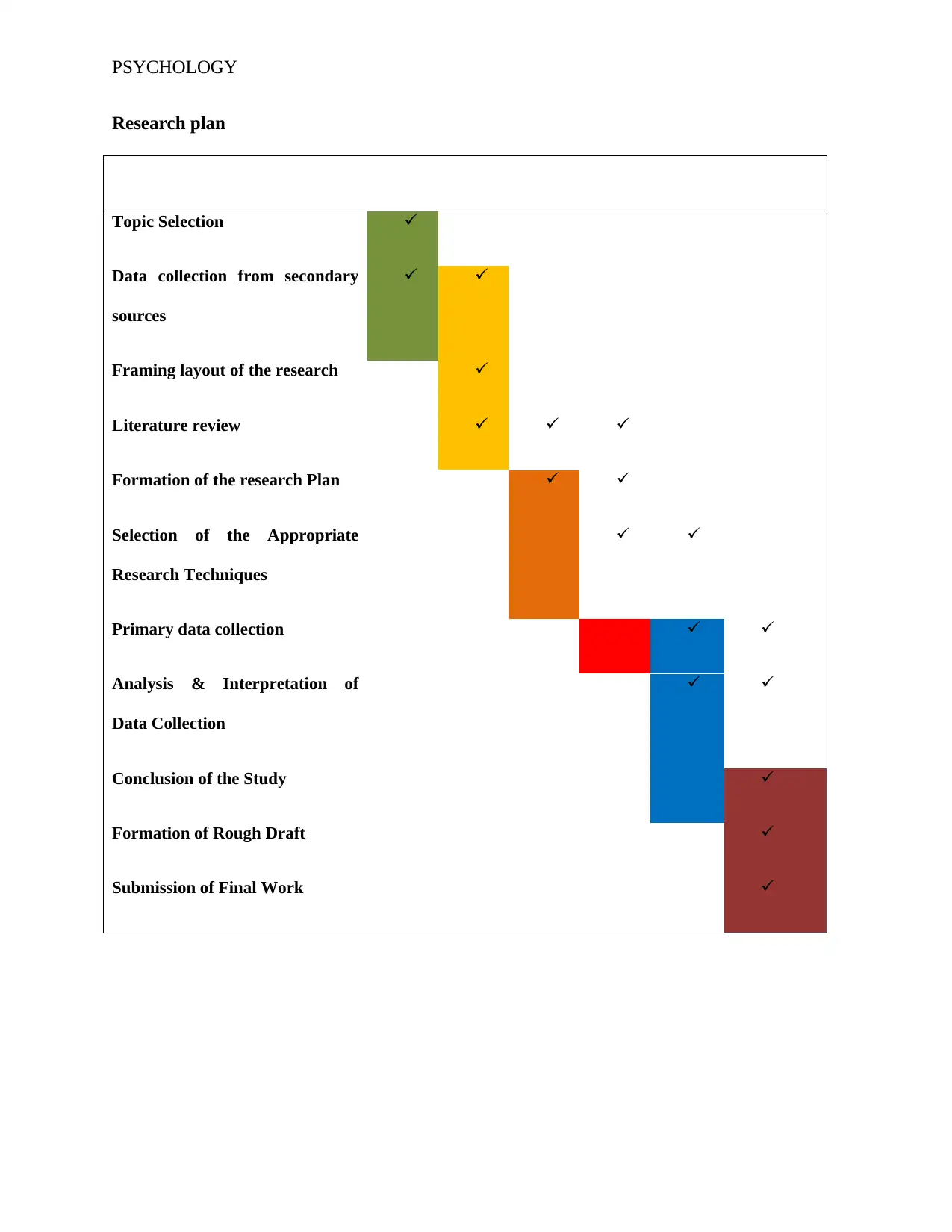
PSYCHOLOGY
Research plan
Main activities/ stages Week1 Week2 Week3 Week4 Week 5 Week 6
Topic Selection
Data collection from secondary
sources
Framing layout of the research
Literature review
Formation of the research Plan
Selection of the Appropriate
Research Techniques
Primary data collection
Analysis & Interpretation of
Data Collection
Conclusion of the Study
Formation of Rough Draft
Submission of Final Work
Research plan
Main activities/ stages Week1 Week2 Week3 Week4 Week 5 Week 6
Topic Selection
Data collection from secondary
sources
Framing layout of the research
Literature review
Formation of the research Plan
Selection of the Appropriate
Research Techniques
Primary data collection
Analysis & Interpretation of
Data Collection
Conclusion of the Study
Formation of Rough Draft
Submission of Final Work
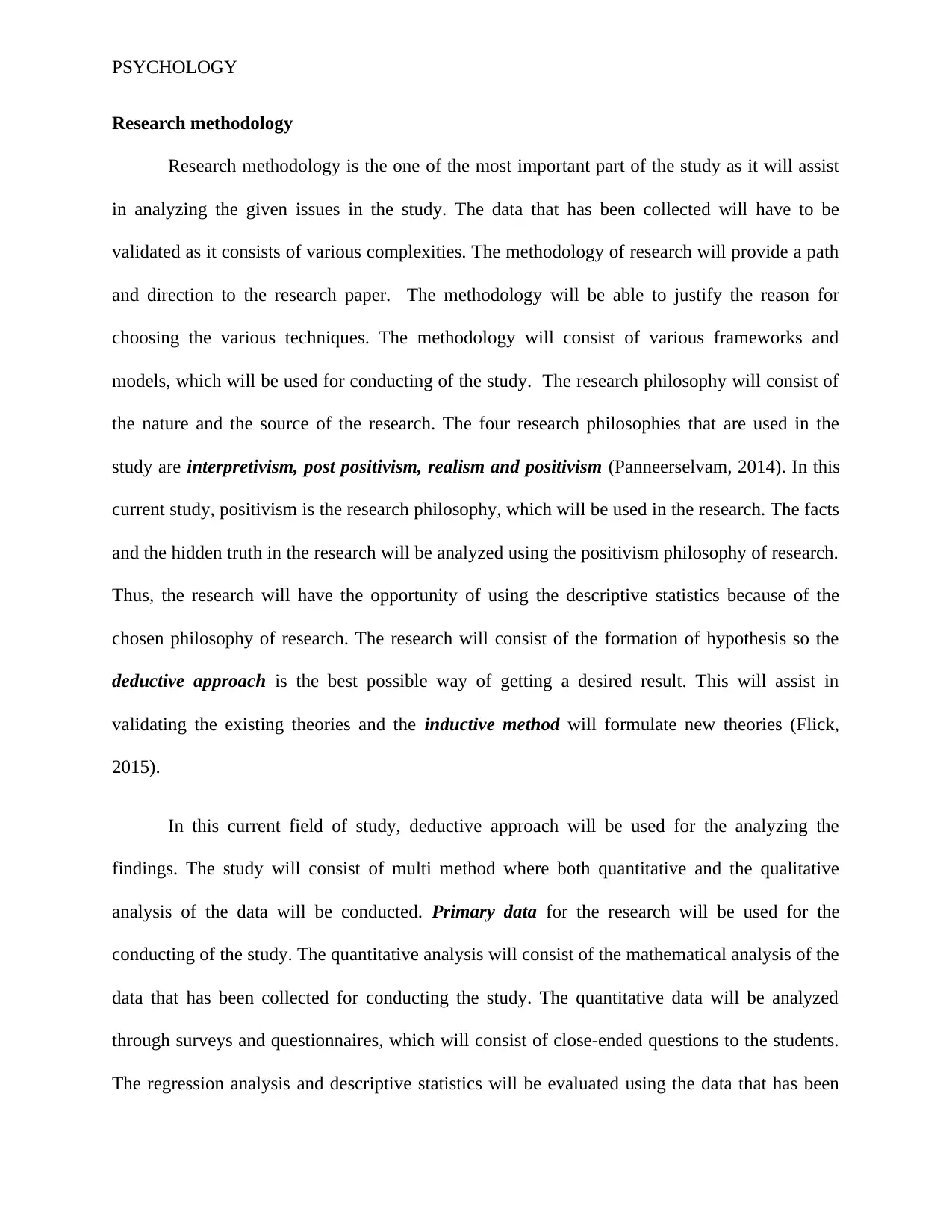
PSYCHOLOGY
Research methodology
Research methodology is the one of the most important part of the study as it will assist
in analyzing the given issues in the study. The data that has been collected will have to be
validated as it consists of various complexities. The methodology of research will provide a path
and direction to the research paper. The methodology will be able to justify the reason for
choosing the various techniques. The methodology will consist of various frameworks and
models, which will be used for conducting of the study. The research philosophy will consist of
the nature and the source of the research. The four research philosophies that are used in the
study are interpretivism, post positivism, realism and positivism (Panneerselvam, 2014). In this
current study, positivism is the research philosophy, which will be used in the research. The facts
and the hidden truth in the research will be analyzed using the positivism philosophy of research.
Thus, the research will have the opportunity of using the descriptive statistics because of the
chosen philosophy of research. The research will consist of the formation of hypothesis so the
deductive approach is the best possible way of getting a desired result. This will assist in
validating the existing theories and the inductive method will formulate new theories (Flick,
2015).
In this current field of study, deductive approach will be used for the analyzing the
findings. The study will consist of multi method where both quantitative and the qualitative
analysis of the data will be conducted. Primary data for the research will be used for the
conducting of the study. The quantitative analysis will consist of the mathematical analysis of the
data that has been collected for conducting the study. The quantitative data will be analyzed
through surveys and questionnaires, which will consist of close-ended questions to the students.
The regression analysis and descriptive statistics will be evaluated using the data that has been
Research methodology
Research methodology is the one of the most important part of the study as it will assist
in analyzing the given issues in the study. The data that has been collected will have to be
validated as it consists of various complexities. The methodology of research will provide a path
and direction to the research paper. The methodology will be able to justify the reason for
choosing the various techniques. The methodology will consist of various frameworks and
models, which will be used for conducting of the study. The research philosophy will consist of
the nature and the source of the research. The four research philosophies that are used in the
study are interpretivism, post positivism, realism and positivism (Panneerselvam, 2014). In this
current study, positivism is the research philosophy, which will be used in the research. The facts
and the hidden truth in the research will be analyzed using the positivism philosophy of research.
Thus, the research will have the opportunity of using the descriptive statistics because of the
chosen philosophy of research. The research will consist of the formation of hypothesis so the
deductive approach is the best possible way of getting a desired result. This will assist in
validating the existing theories and the inductive method will formulate new theories (Flick,
2015).
In this current field of study, deductive approach will be used for the analyzing the
findings. The study will consist of multi method where both quantitative and the qualitative
analysis of the data will be conducted. Primary data for the research will be used for the
conducting of the study. The quantitative analysis will consist of the mathematical analysis of the
data that has been collected for conducting the study. The quantitative data will be analyzed
through surveys and questionnaires, which will consist of close-ended questions to the students.
The regression analysis and descriptive statistics will be evaluated using the data that has been
⊘ This is a preview!⊘
Do you want full access?
Subscribe today to unlock all pages.

Trusted by 1+ million students worldwide
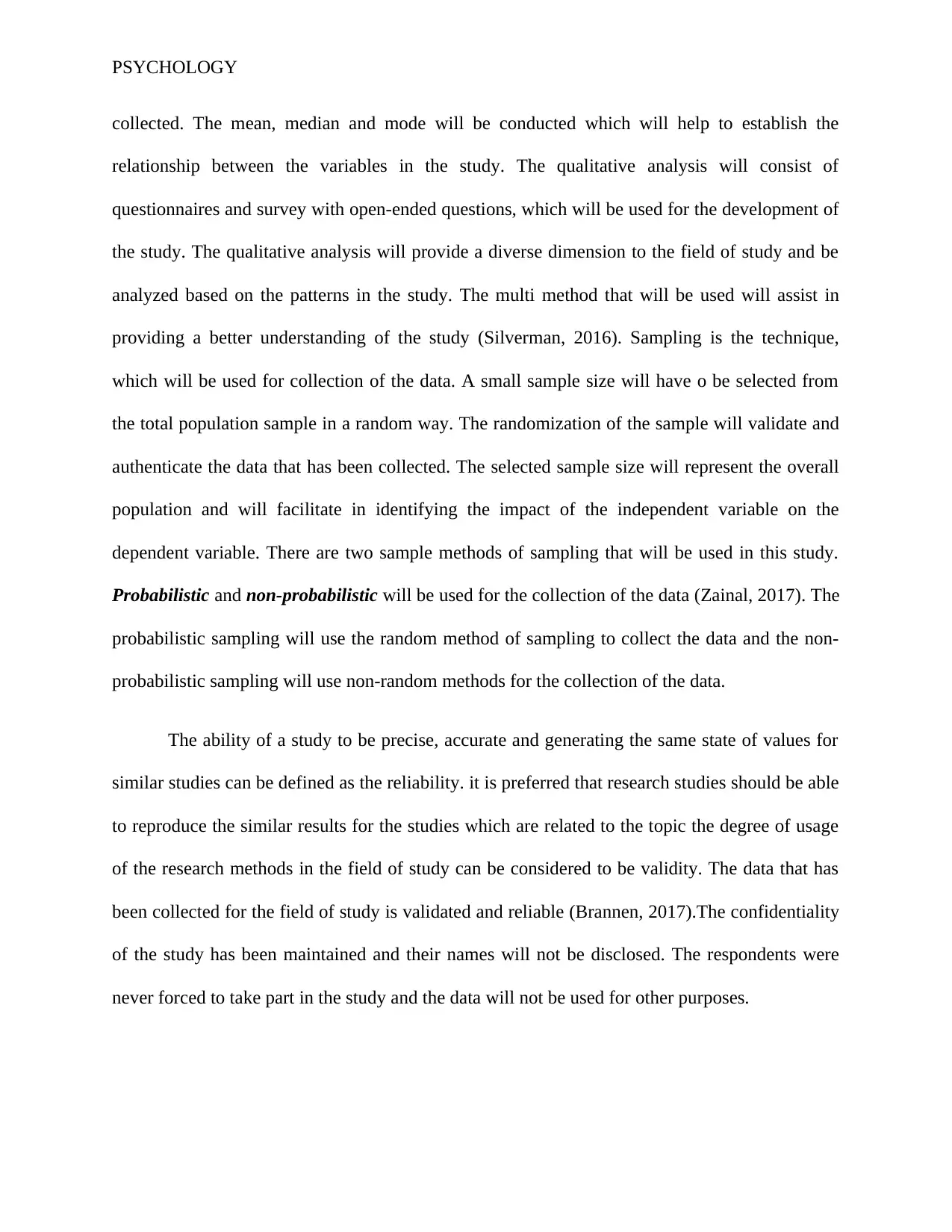
PSYCHOLOGY
collected. The mean, median and mode will be conducted which will help to establish the
relationship between the variables in the study. The qualitative analysis will consist of
questionnaires and survey with open-ended questions, which will be used for the development of
the study. The qualitative analysis will provide a diverse dimension to the field of study and be
analyzed based on the patterns in the study. The multi method that will be used will assist in
providing a better understanding of the study (Silverman, 2016). Sampling is the technique,
which will be used for collection of the data. A small sample size will have o be selected from
the total population sample in a random way. The randomization of the sample will validate and
authenticate the data that has been collected. The selected sample size will represent the overall
population and will facilitate in identifying the impact of the independent variable on the
dependent variable. There are two sample methods of sampling that will be used in this study.
Probabilistic and non-probabilistic will be used for the collection of the data (Zainal, 2017). The
probabilistic sampling will use the random method of sampling to collect the data and the non-
probabilistic sampling will use non-random methods for the collection of the data.
The ability of a study to be precise, accurate and generating the same state of values for
similar studies can be defined as the reliability. it is preferred that research studies should be able
to reproduce the similar results for the studies which are related to the topic the degree of usage
of the research methods in the field of study can be considered to be validity. The data that has
been collected for the field of study is validated and reliable (Brannen, 2017).The confidentiality
of the study has been maintained and their names will not be disclosed. The respondents were
never forced to take part in the study and the data will not be used for other purposes.
collected. The mean, median and mode will be conducted which will help to establish the
relationship between the variables in the study. The qualitative analysis will consist of
questionnaires and survey with open-ended questions, which will be used for the development of
the study. The qualitative analysis will provide a diverse dimension to the field of study and be
analyzed based on the patterns in the study. The multi method that will be used will assist in
providing a better understanding of the study (Silverman, 2016). Sampling is the technique,
which will be used for collection of the data. A small sample size will have o be selected from
the total population sample in a random way. The randomization of the sample will validate and
authenticate the data that has been collected. The selected sample size will represent the overall
population and will facilitate in identifying the impact of the independent variable on the
dependent variable. There are two sample methods of sampling that will be used in this study.
Probabilistic and non-probabilistic will be used for the collection of the data (Zainal, 2017). The
probabilistic sampling will use the random method of sampling to collect the data and the non-
probabilistic sampling will use non-random methods for the collection of the data.
The ability of a study to be precise, accurate and generating the same state of values for
similar studies can be defined as the reliability. it is preferred that research studies should be able
to reproduce the similar results for the studies which are related to the topic the degree of usage
of the research methods in the field of study can be considered to be validity. The data that has
been collected for the field of study is validated and reliable (Brannen, 2017).The confidentiality
of the study has been maintained and their names will not be disclosed. The respondents were
never forced to take part in the study and the data will not be used for other purposes.
Paraphrase This Document
Need a fresh take? Get an instant paraphrase of this document with our AI Paraphraser
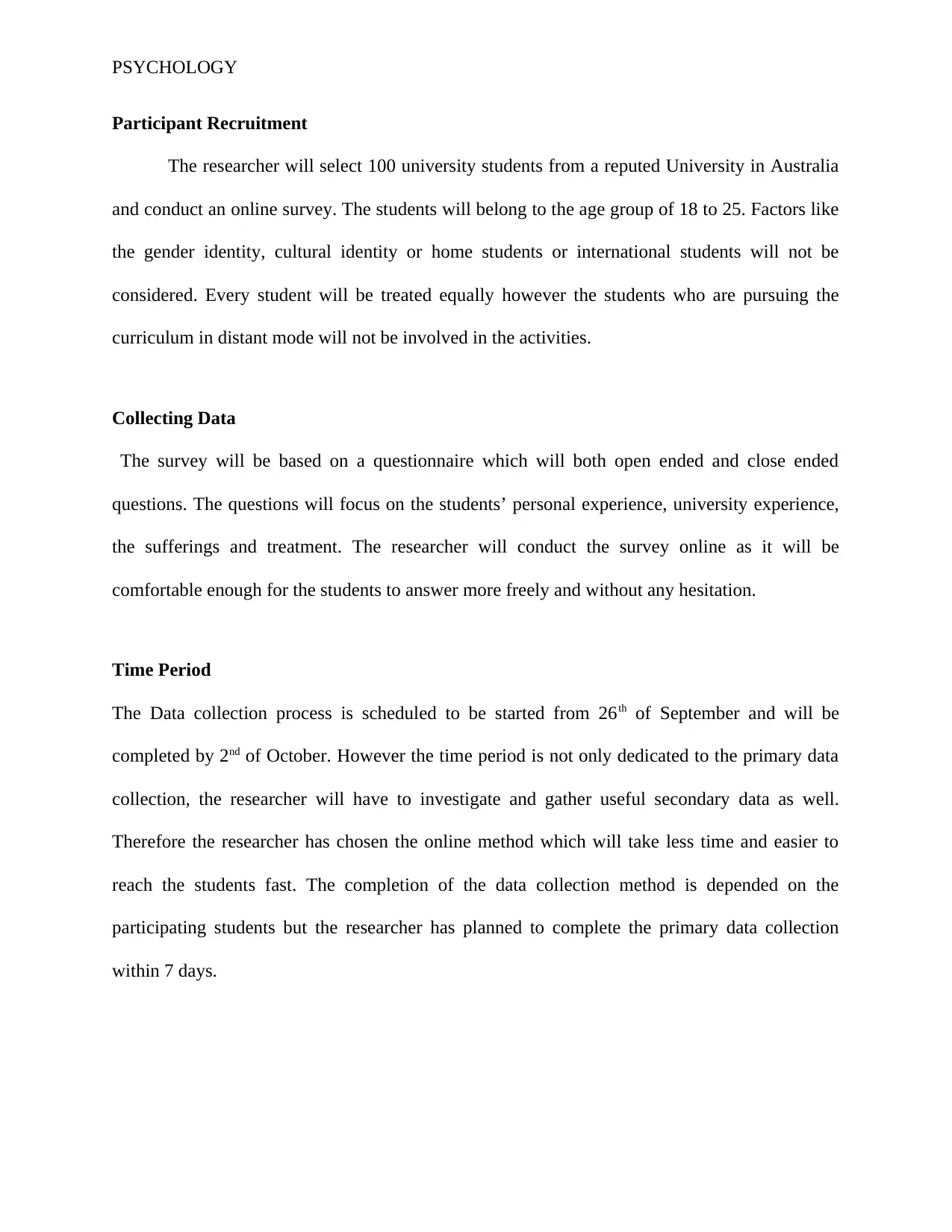
PSYCHOLOGY
Participant Recruitment
The researcher will select 100 university students from a reputed University in Australia
and conduct an online survey. The students will belong to the age group of 18 to 25. Factors like
the gender identity, cultural identity or home students or international students will not be
considered. Every student will be treated equally however the students who are pursuing the
curriculum in distant mode will not be involved in the activities.
Collecting Data
The survey will be based on a questionnaire which will both open ended and close ended
questions. The questions will focus on the students’ personal experience, university experience,
the sufferings and treatment. The researcher will conduct the survey online as it will be
comfortable enough for the students to answer more freely and without any hesitation.
Time Period
The Data collection process is scheduled to be started from 26th of September and will be
completed by 2nd of October. However the time period is not only dedicated to the primary data
collection, the researcher will have to investigate and gather useful secondary data as well.
Therefore the researcher has chosen the online method which will take less time and easier to
reach the students fast. The completion of the data collection method is depended on the
participating students but the researcher has planned to complete the primary data collection
within 7 days.
Participant Recruitment
The researcher will select 100 university students from a reputed University in Australia
and conduct an online survey. The students will belong to the age group of 18 to 25. Factors like
the gender identity, cultural identity or home students or international students will not be
considered. Every student will be treated equally however the students who are pursuing the
curriculum in distant mode will not be involved in the activities.
Collecting Data
The survey will be based on a questionnaire which will both open ended and close ended
questions. The questions will focus on the students’ personal experience, university experience,
the sufferings and treatment. The researcher will conduct the survey online as it will be
comfortable enough for the students to answer more freely and without any hesitation.
Time Period
The Data collection process is scheduled to be started from 26th of September and will be
completed by 2nd of October. However the time period is not only dedicated to the primary data
collection, the researcher will have to investigate and gather useful secondary data as well.
Therefore the researcher has chosen the online method which will take less time and easier to
reach the students fast. The completion of the data collection method is depended on the
participating students but the researcher has planned to complete the primary data collection
within 7 days.
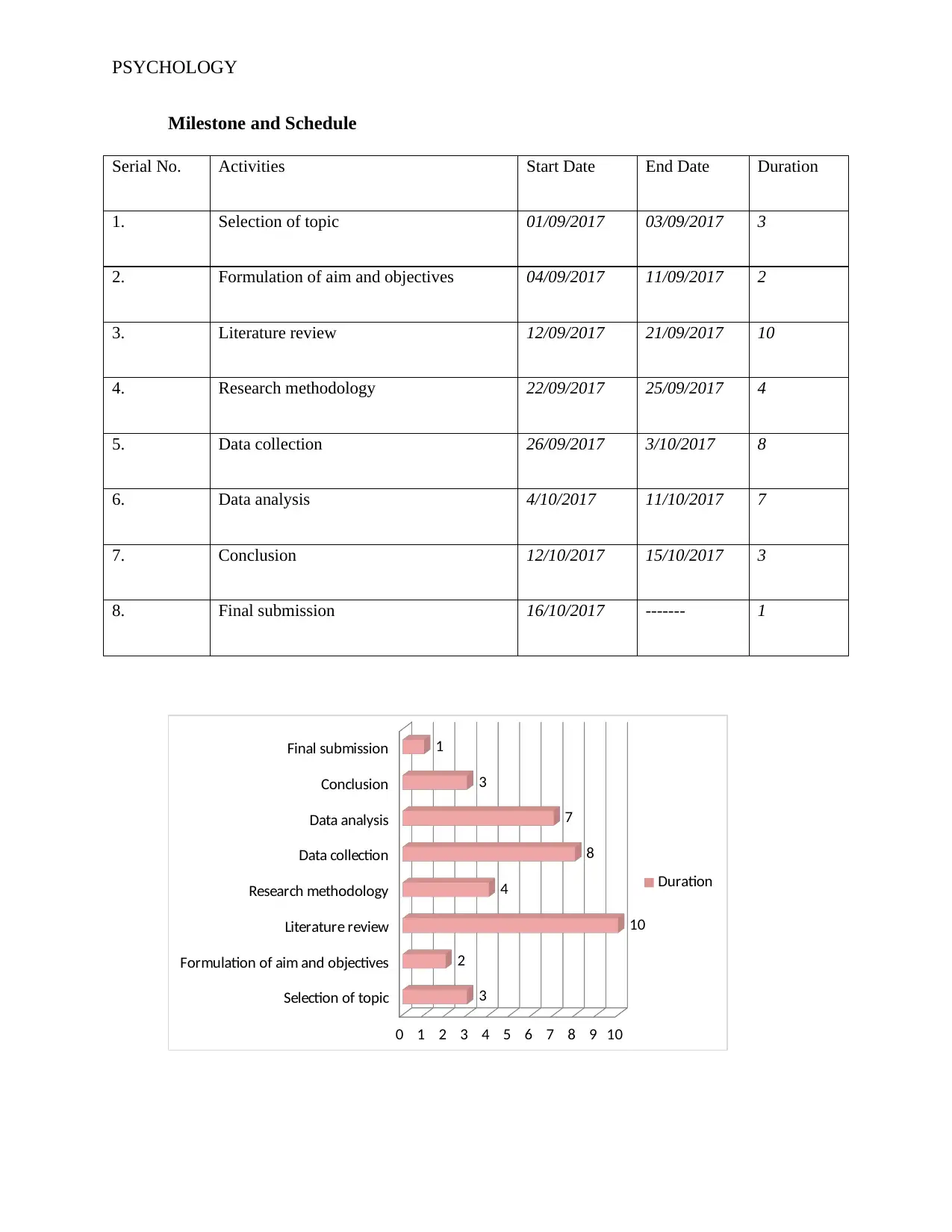
PSYCHOLOGY
Milestone and Schedule
Serial No. Activities Start Date End Date Duration
1. Selection of topic 01/09/2017 03/09/2017 3
2. Formulation of aim and objectives 04/09/2017 11/09/2017 2
3. Literature review 12/09/2017 21/09/2017 10
4. Research methodology 22/09/2017 25/09/2017 4
5. Data collection 26/09/2017 3/10/2017 8
6. Data analysis 4/10/2017 11/10/2017 7
7. Conclusion 12/10/2017 15/10/2017 3
8. Final submission 16/10/2017 ------- 1
Selection of topic
Formulation of aim and objectives
Literature review
Research methodology
Data collection
Data analysis
Conclusion
Final submission
0 1 2 3 4 5 6 7 8 9 10
3
2
10
4
8
7
3
1
Duration
Milestone and Schedule
Serial No. Activities Start Date End Date Duration
1. Selection of topic 01/09/2017 03/09/2017 3
2. Formulation of aim and objectives 04/09/2017 11/09/2017 2
3. Literature review 12/09/2017 21/09/2017 10
4. Research methodology 22/09/2017 25/09/2017 4
5. Data collection 26/09/2017 3/10/2017 8
6. Data analysis 4/10/2017 11/10/2017 7
7. Conclusion 12/10/2017 15/10/2017 3
8. Final submission 16/10/2017 ------- 1
Selection of topic
Formulation of aim and objectives
Literature review
Research methodology
Data collection
Data analysis
Conclusion
Final submission
0 1 2 3 4 5 6 7 8 9 10
3
2
10
4
8
7
3
1
Duration
⊘ This is a preview!⊘
Do you want full access?
Subscribe today to unlock all pages.

Trusted by 1+ million students worldwide
1 out of 15
Related Documents
Your All-in-One AI-Powered Toolkit for Academic Success.
+13062052269
info@desklib.com
Available 24*7 on WhatsApp / Email
![[object Object]](/_next/static/media/star-bottom.7253800d.svg)
Unlock your academic potential
Copyright © 2020–2025 A2Z Services. All Rights Reserved. Developed and managed by ZUCOL.





